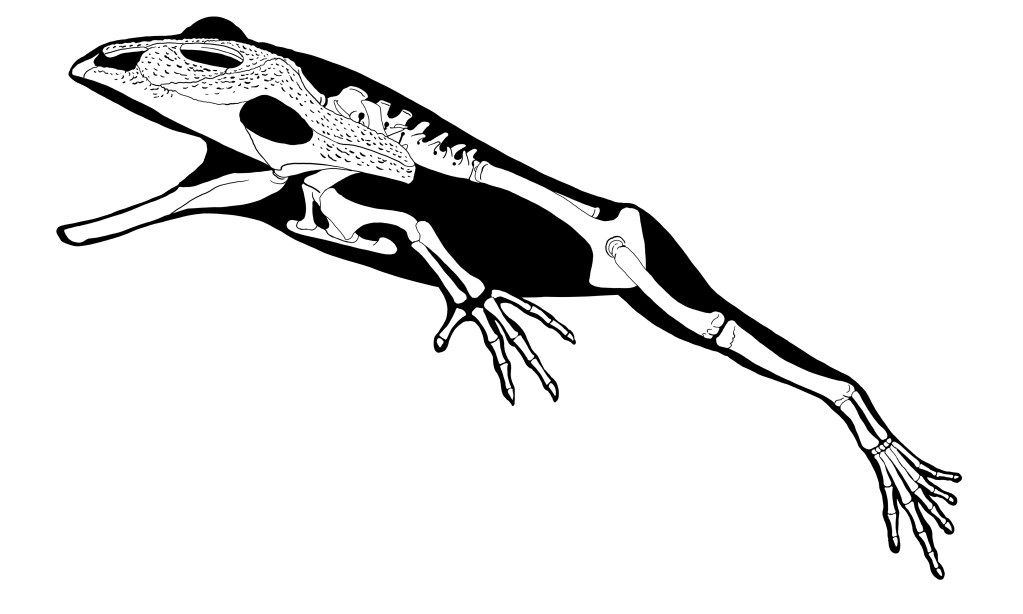Beelzebufo ampinga (Evans, Jones & Krause, 2008) may not be the largest extinct frog, but it was particularly large. Amongst the frogs, it’s amongst the hyperossified members of Ceratophryidae (Hyloidea, Anura) from the Late Cretaceous of Madagascar. There’s not much here for me to say.

Yep, that’s it. Unpreserved elements of the skeleton are rendered after Ceratophrys and similar hyloidean frogs.
Okay, okay, you are asking me why I’m drawing giant frogs. This was inspired by an exchange that occurred more than a decade ago on the Dinosaur Mailing List and elsewhere regarding particular features found amongst various non-dinosaurian tetrapods claimed to relate to bipedalism, notably (most importantly) a long anterior process of the ilium. But this feature appears in a lot of quadrupedal tetrapods, frogs not the least amongst them, as well as many, many mammals (of which very few are functionally bipedal).
More recently on this blog, said reconstructor claimed my Sharovipteryx skeletal reconstruction somehow affirmed a belief that it was bipedal. Like the frog above, the reconstruction was presenting the animal in the act of leaping, a behavior that is performed more or less quadrupedally with massive thrust from the hindlegs. Similar behavior is observed in bats and is hypothesized for pterosaurs (see Habib, 2008 for practical and theoretical research on this topic).

Now, I will admit a fondness for Blurrgs in the Star Wars universe. They featured in the Ewok Movie “Battle for Endor” and later in the first season of “The Mandalorian,” where best-character Kuiil raises and trains them for his farm. Thus did the idea occur to me that a ridiculous argument require a ridiculous response. This is the only practical reason to which I think applications like irregular or completely erroneous reconstructions should be put to; to subvert or describe an argument that is unfounded allows such flexible thinking. Thus, let me reiterate that the second skeletal reconstruction (above) and the life reconstruction (below) are not presented with an argument these are authentic to my views on the actual animal’s reconstruction (image at top).
References
Evans, S. E., Jones, M. E. H. & Krause, D. W. 2008. A giant frog with South American affinities from the Late Cretaceous of Madagascar. Proceedings of the National Academy of Sciences 105(8): 2951-2956.
Habib, M. B. 2008. Comparative evidence for quadrupedal launch in pterosaurs. Zitteliana B28: 159-166.




I’m really enjoying watching this fight play out.
I’m into microbes, but my young son’s passion forced me to learn a lot about ancient herps to answer his constant questions, which is how I found your blog. Glad it’s resurrected.
https://gfycat.com/emotionalnarrowfrillneckedlizard
There is a paper about new materials of Beelzebufo in 2014, and it shows that it should have much shorter legs.
https://www.ncbi.nlm.nih.gov/pmc/articles/PMC3905036/
After that, I realized that I was simply comparing it to the side view of the original treatise. Seen from the vertical, the skeleton of your figure and the treatise are almost the same, so it is ok.
Hi! Yes. I tried to scale the legs properly, and for a frog the legs are very short, but it looks longer *because* the animal is leaping, the legs are stretched out. It may not have been a well-adapted leaper, but it could probably do so anyways.
I really like the work you’ve done here.
Well, this scientific argument is wonderful; and exactly what should be done: argument is the basis for scientific discovery.
This’s really interesting; and I thank you for posting this.